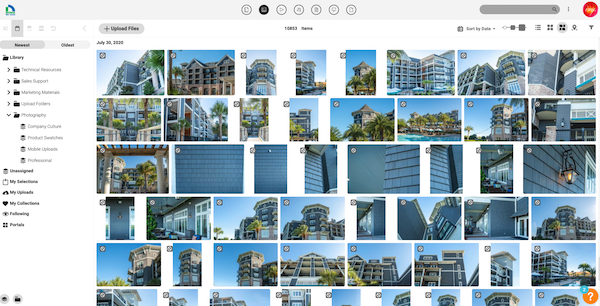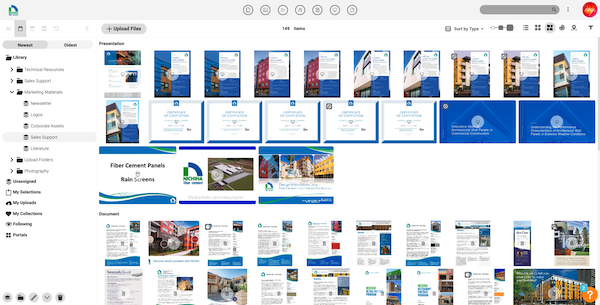Nichiha uses Canto to arm sales team with marketing resources

For over 20 years, Nichiha has wowed the manufacturing world with their innovative fiber cement panels. Nichiha’s siding solutions can be used for both commercial and residential construction projects, and either on full wraps of buildings or accent walls. Their panels resemble wood, stone or brick, and can even be color-customized.
Ivy Bohn, Nichiha’s Marketing Supervisor, is the ‘catch-all’ member of the marketing team. She manages the company’s marketing communications, which means she is responsible for many marketing facets – photography, sales support, event planning, copywriting and public relations, just to name a few!
Goal: Improve content-sharing workflows
The submittal process for construction projects is very visual, so the Nichiha team relies on photography and architectural drawings to sell their fiber cement panels. Whether it’s product imagery or technical details, they ensure that future customers get the information they need quickly and easily.
Accessing key product information was challenging because, with their previous system, digital assets were only available to marketing. This left the sales team with no choice but to request assets from the marketing team every single time they needed to send a one-off photo or had to prepare a submittal package for a potential customer.
“In the past, our marketing department kept everything locked up – the sales team couldn’t even get to the content. Sales and marketing were completely separate. The only way the ‘easy to buy, easy to sell’ goal was going to work was for marketing and sales to be on the same page,” says Ivy.

Nichiha’s brand assets were behind closed doors because their digital asset system was unorganized and slow. It was a hassle to find requested assets, and even more of a hassle to email them one-by-one. The process led to a lot of frustration and lost time.
“We had an off-base server that would be linked to a PDF, and the PDF had links to different file sources. Sometimes they’d be broken, sometimes they’d have incorrect labels. No one could find anything,” says Ivy.
“I tried to get it organized and couldn’t because it was just so slow. If someone wanted pictures or they wanted different forms, they just emailed us. And that’s how we were forced to operate. It was a mess.”

Ivy decided that it was crucial for the marketing team to be able to easily centralize, organize and share their assets, so she led the search for a digital asset management (DAM) solution.
“When I was with the company for about six months, I started petitioning for us to get a DAM within our budget. We didn’t have a good, easy place for the company, the sales team in particular, to access content,” says Ivy.
Nichiha tested a few solutions, but ultimately decided to implement Canto for its user-friendliness, visual components and tagging capabilities.
“A big point in choosing Canto was that it’s very visual – it’s even more visual now than when we purchased it two years ago. We needed a solution where we had a preview of the content and could see it quickly. Along with that, it’s very user-friendly. I was having a hard time using the other solutions we tested, and I thought ‘If I can’t understand this as a marketer, will the rest of the company?’ With Canto, you can just hover over icons and it’ll tell you exactly what the button does,” says Ivy.

Enter Canto: A centralized content repository
Nichiha now centralizes all of their product imagery, videos and brand assets in Canto. With over 10,000 pieces of content, the migration from their old system to Canto was a hefty task, but Ivy says that the process was as smooth as possible.
“The process of getting the assets over to Canto was smooth. It was simple to put things where I needed them. Canto is quick to catch on to what we’re uploading with Smart Tags, and it’s a quick upload time,” says Ivy.
Getting organized
The Nichiha team implemented a comprehensive tagging strategy to keep their Canto library clean and organized. Since they have so many product lines and variations within each line, tags enable everyone to instantly search for and find what they need.
“First we tag by product, then the product type division. Then we have a whole list of things that we tag, like location, sales rep name, project name, date and color. We even tag installation things that are happening in the image,” says Ivy.

Additionally, they use the Canto search feature as an internal content search engine and are pleased with its intuitive functionality.
“We have Monday morning kickoff meetings, and in the last one we were planning our new case study lookbook. We talked about community design and what community projects we may have. We already tag things by community, so I was able to jump in Canto and search and find exactly what we were looking for,” says Ivy.
Bolstering external partner relationships
Ivy gathers relevant imagery and technical information for each product line and places it in a Canto Collection, which is then sent off to dealers, distributors or architects. The external partners have access to the content Ivy wants them to see, and they can download photos or specification documents for their own use.
Now that the team uses Canto, all of this information is easily found internally and shared externally.
“We have a lot of technical information in Canto that we add to different submittal packages. If an architect is looking to use one of our products, we have a whole submittal package ready to go. We send them to Canto and they’re able to get all the information needed for the project – technical specifications, photography samples, everything. We’re able to offer the architect or the builder a whole catalog for inspiration,” says Ivy.

Small team, big results
Nichiha’s three-person marketing team needs their workflows to be as streamlined as possible. With Canto, they quickly curate unique, self-serve photography libraries for internal and external stakeholders. Photography is foundational to Nichiha’s marketing success, and they stay ahead of the competition and showcase it all in Canto.
“We try to see what our competitors are doing and actively do the opposite. One of those things is our photography. If you want to see a product on a specific building, like a restaurant, home or firehouse, you can find the image in Canto. We have all this photography to offer that our competitors don’t, and Canto is our photography home base,” says Ivy.
Results: “Easy to buy, easy to sell”
Canto helped open the door between the marketing and sales teams, which resulted in streamlined workflows and successful communication. As their content library grows, the Nichiha team knows that all up-to-date photos and submittal packages can be found in Canto.
“We’re in it all the time, especially as our photography library keeps growing and growing. If something is created, it’s immediately put in Canto. Everyone is able to see all of our assets laid out,” says Ivy.
The simple, grab-and-go process for submittal packages and other brand assets in Canto empowers the Nichiha team to move fast and sell more.
“Canto is really the backbone of what the marketing department does. We use it for everything. Without it, everything would be slowed down,” says Ivy.
Keep your team moving with digital asset management. Download our free eBook: Digital asset management for beginners